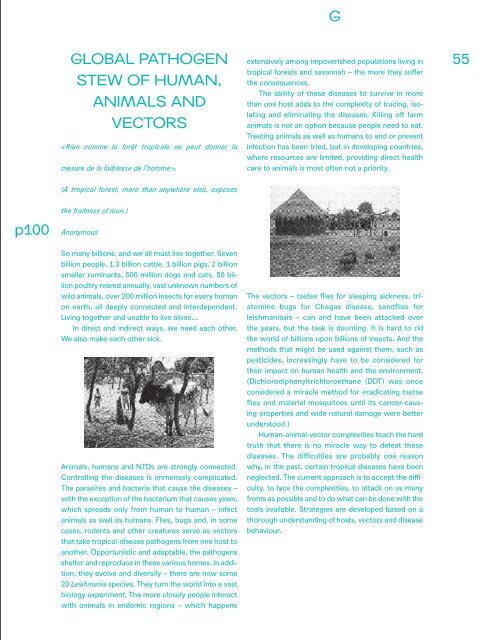You also want an ePaper? Increase the reach of your titles
YUMPU automatically turns print PDFs into web optimized ePapers that Google loves.
G<br />
GLOBAL PATHOGEN<br />
STEW OF HUMAN,<br />
ANIMALS AND<br />
VECTORS<br />
« Rien comme la forêt tropicale ne peut donner la<br />
mesure de la faiblesse de l’homme ».<br />
extensively among impoverished populations living in<br />
tropical forests and savannah – the more they suffer<br />
the consequences.<br />
The ability of these diseases to survive in more<br />
than one host adds to the complexity of tracing, isolating<br />
and eliminating the diseases. Killing off farm<br />
animals is not an option because people need to eat.<br />
Treating animals as well as humans to end or prevent<br />
infection has been tried, but in developing countries,<br />
where resources are limited, providing direct health<br />
care to animals is most often not a priority.<br />
55<br />
(A tropical forest, more than anywhere else, exposes<br />
p100<br />
the frailness of man.)<br />
Anonymous<br />
So many billions, and we all must live together. Seven<br />
billion people, 1.3 billion cattle, 1 billion pigs, 2 billion<br />
smaller ruminants, 500 million dogs and cats, 50 billion<br />
poultry reared annually, vast unknown numbers of<br />
wild animals, over 200 million insects for every human<br />
on earth, all deeply connected and interdependent.<br />
Living together and unable to live alone…<br />
In direct and indirect ways, we need each other.<br />
We also make each other sick.<br />
Animals, humans and NTDs are strongly connected.<br />
Controlling the diseases is immensely complicated.<br />
The parasites and bacteria that cause the diseases –<br />
with the exception of the bacterium that causes yaws,<br />
which spreads only from human to human – infect<br />
animals as well as humans. Flies, bugs and, in some<br />
cases, rodents and other creatures serve as vectors<br />
that take tropical-disease pathogens from one host to<br />
another. Opportunistic and adaptable, the pathogens<br />
shelter and reproduce in these various homes. In addition,<br />
they evolve and diversify – there are now some<br />
20 Leishmania species. They turn the world into a vast<br />
biology experiment. The more closely people interact<br />
with animals in endemic regions – which happens<br />
The vectors – tsetse flies for sleeping sickness, triatomine<br />
bugs for Chagas disease, sandflies for<br />
leishmaniasis – can and have been attacked over<br />
the years, but the task is daunting. It is hard to rid<br />
the world of billions upon billions of insects. And the<br />
methods that might be used against them, such as<br />
pesticides, increasingly have to be considered for<br />
their impact on human health and the environment.<br />
(Dichlorodiphenyltrichloroethane (DDT) was once<br />
considered a miracle method for eradicating tsetse<br />
flies and malarial mosquitoes until its cancer-causing<br />
properties and wide natural damage were better<br />
understood.)<br />
Human-animal-vector complexities teach the hard<br />
truth that there is no miracle way to defeat these<br />
diseases. The difficulties are probably one reason<br />
why, in the past, certain tropical diseases have been<br />
neglected. The current approach is to accept the difficulty,<br />
to face the complexities, to attack on as many<br />
fronts as possible and to do what can be done with the<br />
tools available. Strategies are developed based on a<br />
thorough understanding of hosts, vectors and disease<br />
behaviour.


